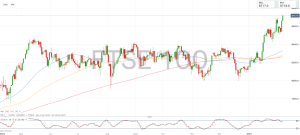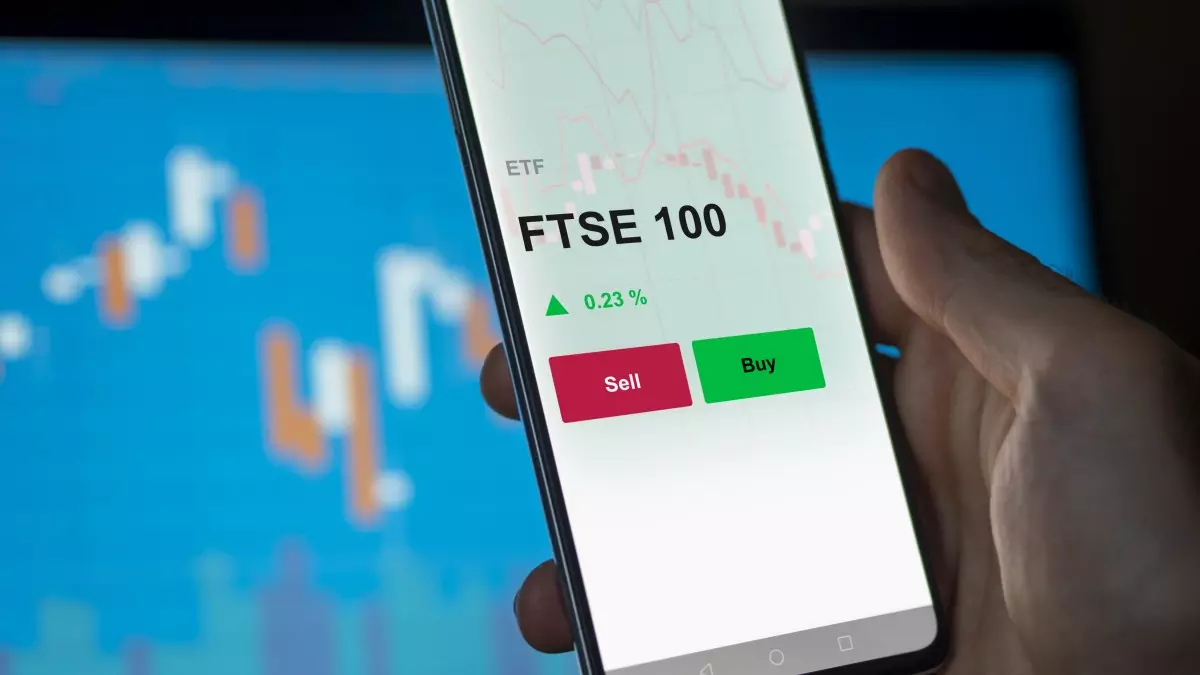The FTSE 100, often referred to as "Footsie," is one of the world's most prominent stock market indexes, comprising the top 100 companies listed on the London Stock Exchange. Its performance is influenced by a myriad of factors, ranging from economic indicators to geopolitical events. This article delves into the key drivers of FTSE 100 performance, providing insights for investors and market enthusiasts.
FTSE 100, stock market, economic indicators, corporate earnings, geopolitical events, investor sentiment, interest rates, global markets
Economic Indicators and Market Sentiment

The FTSE 100 is a barometer for the health of the UK economy, but its performance is not confined to domestic factors alone. A host of economic indicators, both local and global, play a pivotal role in shaping its trajectory. Understanding these factors is essential for investors aiming to navigate the market effectively.
1. Economic Growth and GDP
Gross Domestic Product (GDP) is a cornerstone of economic health. When the UK economy expands, consumer spending, business investment, and corporate profits tend to rise, directly benefiting the companies listed on the FTSE 100. A strong GDP growth rate often translates into higher stock prices, as investors anticipate increased earnings and dividends. Conversely, a slowing economy can weigh on the index, as market participants worry about reduced profitability and economic instability.
2. Inflation and Consumer Spending
Inflation is another critical factor that impacts the FTSE 100. While low inflation can be a double-edged sword—on one hand, it keeps borrowing costs low, but on the other, it may indicate stagnation or deflationary pressures—moderate inflation is generally seen as healthy. High inflation, however, can erode consumer purchasing power, leading to decreased spending and, consequently, lower corporate revenues. Central banks, such as the Bank of England, often respond to high inflation with interest rate hikes, which can冷却股市 investor sentiment and weigh on stock prices.
3. Employment Levels and Wage Growth
Employment levels and wage growth are closely monitored by investors as they reflect the overall health of the labor market. A strong job market, with rising wages, tends to boost consumer confidence and spending, which in turn supports the profits of consumer-facing companies within the FTSE 100. Conversely, high unemployment or stagnant wages can lead to reduced demand for goods and services, impacting corporate earnings and stock valuations.
4. Global Economic Conditions
The FTSE 100 is not an island unto itself. As a significant player in the global financial markets, its performance is heavily influenced by global economic trends. For instance, a slowdown in major economies like the United States, China, or the Eurozone can impact UK exports and, consequently, the performance of FTSE 100 companies that rely heavily on international trade. Additionally, global commodity prices, particularly oil and metals, can affect sectors such as energy and mining, which make up a significant portion of the index.
5. Central Bank Policies and Interest Rates
The policies of the Bank of England (BoE) are a critical driver of the FTSE 100's performance. Interest rates, in particular, have a direct impact on borrowing costs for businesses and consumers. Low interest rates tend to stimulate economic activity, encouraging investing in equities as bond yields become less attractive. Conversely, rate hikes can cool down an overheating economy but may also increase borrowing costs, reducing corporate profitability and dampening investor sentiment.
6. Market Sentiment and Investor Psychology
While tangible economic indicators play a significant role in the FTSE 100’s performance, so too does investor sentiment. Market psychology can swing sharply based on news, rumors, or even global events, leading to volatility. For instance, uncertainty surrounding Brexit or geopolitical tensions can cause investors to seek safer assets, such as government bonds, at the expense of equities. On the other hand, positive sentiment, driven by optimism about future earnings or economic growth, can propel the index higher.
The FTSE 100’s performance is a reflection of a complex interplay between domestic and global economic factors, corporate health, and investor sentiment. By understanding these drivers, investors can gain a clearer picture of the forces shaping the market and make more informed decisions.
Corporate Earnings and Geopolitical Risks
While macroeconomic factors provide a broad context for the FTSE 100’s performance, the index is ultimately driven by the financial health and profitability of its constituent companies. Corporate earnings, sector-specific dynamics, and geopolitical risks are critical elements that investors must consider when analyzing the index.
1. Corporate Earnings and Profitability
The performance of the FTSE 100 is heavily influenced by the earnings reports of its constituent companies. Companies that exceed earnings expectations often see their stock prices rise, boosting the overall index. Conversely, underwhelming results can lead to sell-offs, dragging the index lower. Key sectors, such as banking, oil and gas, and pharmaceuticals, have a significant weight in the index, meaning their performance can have a disproportionate impact on its trajectory.
Investors closely monitor earnings reports, as well as guidance for future quarters, to assess the health of individual companies and the broader economy. For instance, if oil prices rise, energy companies within the FTSE 100 may report stronger profits, lifting the index. Similarly, if consumer-facing companies report robust sales, it can signal improving consumer confidence and economic growth.
2. Earnings Yields and Valuation Metrics
In addition to absolute earnings figures, investors also focus on valuation metrics such as earnings yields and price-to-earnings (P/E) ratios. The earnings yield, calculated as earnings per share divided by the share price, provides a measure of the attractiveness of equities relative to other asset classes, such as bonds. A rising earnings yield suggests that stocks are becoming more attractive, potentially driving demand and lifting the index.
However, it’s important to consider these metrics in the context of broader economic conditions. For example, during periods of high inflation, higher earnings may not necessarily translate into higher valuations if investors are concerned about future profitability or economic stability.
3. Sector-Specific Dynamics
The FTSE 100 is composed of companies from various sectors, each with its own set of challenges and opportunities. For instance, the performance of the energy sector is heavily influenced by oil prices, geopolitical tensions in key oil-producing regions, and global demand. Similarly, the banking sector is sensitive to interest rates, regulatory changes, and economic growth, as these factors impact lending margins and loan demand.
Technology and pharmaceutical companies, on the other hand, are often driven by innovation, regulatory approvals, and global demand for their products. Companies in these sectors may experience significant volatility based on news related to new product launches, mergers and acquisitions, or regulatory changes.
4. Geopolitical Risks and Global Events
Geopolitical risks and global events are another critical factor influencing the FTSE 100’s performance. Events such as trade disputes, political instability, elections, and conflicts can create uncertainty in the markets, leading to volatility. For instance, the ongoing tensions between the United States and China, or the impact of Brexit on UK trade relations, have had significant implications for the FTSE 100.
Moreover, currency fluctuations can impact the performance of companies with significant international operations. A strong pound can make UK exports less competitive, while a weak pound can boost the profits of companies that generate revenue in foreign currencies. This dual impact means that currency movements can have a complex and sometimes contradictory effect on the index.
5. Regulatory and Policy Changes
Regulatory changes and government policies can also have a profound impact on the FTSE 100. For example, changes in tax policy, environmental regulations, or antitrust laws can affect the profitability and valuation of companies. Additionally, central bank policies, such as quantitative easing or tapering, can influence market liquidity and investor behavior, impacting the index’s performance.
Sustainability and ESG (Environmental, Social, and Governance) factors are increasingly becoming a focus for investors. Companies that demonstrate strong ESG performance are often viewed as more stable and resilient in the long term, which can positively impact their stock prices and the overall index.
6. Technological Advancements and Innovation
In an era of rapid technological change, innovation plays a crucial role in shaping the performance of the FTSE 100. Companies that invest in research and development, adopt emerging technologies, or disrupt traditional industries are often better positioned to generate long-term growth. For instance, advancements in artificial intelligence, renewable energy, and digital transformation are reshaping industries and creating opportunities for companies within the index.
Moreover, the ability of companies to adapt to changing consumer preferences and market dynamics is critical. Companies that can successfully navigate the transition to a low-carbon economy, for example, are likely to perform better in the long run as investors increasingly prioritize sustainability.
In conclusion, the FTSE 100’s performance is a multifaceted phenomenon, influenced by a wide range of factors, from macroeconomic trends and corporate earnings to geopolitical risks and technological innovation. By staying attuned to these key drivers, investors can make more informed decisions and better navigate the complexities of the stock market. Whether you’re a seasoned investor or a market enthusiast, understanding these factors is essential for thriving in the ever-changing financial landscape.
